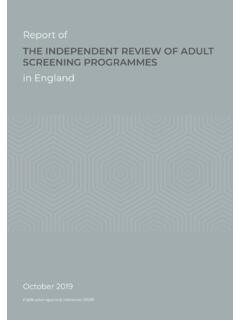Transcription of StoMap Programme Baseline Report 2019 - eoecph.nhs.uk
1 1 East of England NHS Collaborative Procurement Hub Integrated Care Team StoMap Programme Baseline Report 2019 Date: September 2019 Author: Jill Kettle 2 Executive Summary In January 2019 the Secretary of State for Health issued The NHS Long Term Plan1 describing its ambition to review and restructure how we deliver healthcare to our nation s diverse population with a more sustainable approach. The plan sets out its intentions of having a fully integrated community-based health care system for people to receive healthcare and support closer to home with support from local healthcare systems and local authorities. Integrated Care Systems will become the level of the system where commissioners and providers will make shared decisions about financial planning and prioritisation of integrated care. Stoma services and products are on the national NHS improvement agenda.
2 NHS England commissioned a QIPP Programme of work in the North of England specifically to look at how stoma care services are delivered while NHS Supply Chain are also looking at the procurement of stoma products in order to improve the management of patients ongoing stoma care and prescribing needs, while reducing spend on stoma appliances. The StoMap Programme will support the National Bladder and Bowel Health project and ensure that the East of England service development are aligned to the national direction. The East of England NHS Collaborative Procurement Hub is striving to support the national agenda through its StoMap Programme , introducing innovative procurement solutions and service redesign to support the implementation of sustainable service models for our customers. The StoMap Baseline Report outlines key findings from phase one of the StoMap Programme which was a market review for the East of England, to help inform stage 2 of the Programme which will be the development of integrated pathways of care for ostomates across the region.
3 1 Link: 3 Table of Contents Page No 1. 2. The Aims and Objectives of EoECPH StoMap 3. Glossary of 4. National 5. UK Population 6. UK Life 7. Unwarranted 8. Dispensing Appliance 9. Appliance User Review v Clinical 10. Regional 11. Regional Sponsorships and Stoma Care Nurse 12. Supplier Market 13. STP- CCGs v Acute Trusts Products 14. Regional demographic age 15. Projected 20 year 16. Regional Average Spend per 17. CCG Spend and growth 18. CCGs Product spend overview by suppler market 19. Appliance User reviews in 20. Formularies or guidelines for 21. Stoma Open 22. 23. Environmental 24. Summary of Key 25. 26. Contact details for Integrated Care 27. 4 1. Introduction The East of England Collaborative Procurement Hub (EoECPH) is an NHS organisation which supports and assists its members including Sustainability Transformation Partnerships (STP s), Integrated Care Systems (ICS), Acute Trusts, Mental Health Trusts, Clinical Commissioning Groups, Medicines Optimisation Management and all of the Ambulance Trusts within the UK in the procurement of goods and services.
4 The StoMap Programme was developed to support the national QIPP Programme to ensure our members are aligned to the ambitions of the NHS Long Term Plan. The strategy for the EoECPH is to work collaboratively with STP s/ICS s within the East of England region (EoE) to enhance patient pathways and outcomes, and to assist in finding efficiencies within the service delivery and procurement of goods whilst enabling the introduction of innovation through use of technology and innovative contracting models. The STPs/ICSs included in the StoMap Programme are: Cambridge & Peterborough Hertfordshire & West Hertfordshire Mid & South Essex Milton Keynes, Luton & Bedford Norfolk & Waveney Suffolk & North East Essex Data was sourced from ePact (prescription spend) and NHS Supply Chain (trust spend) and with the assistance from manufacturers and Collaborative Procurement Partnership (CPP- Category Tower 5). This Programme has been working with key partners to develop this Baseline Report including; QIPP national lead for stoma, The Clinical Procurement Partnership, regional stoma care nurses, The Association of Stoma Care Nurses, regional medicines optimisation leads, Patient Ostomy Associations, Manufacturers, the British Healthcare Trades Association and Dispensing Appliance Contractors.
5 This Baseline Report discusses the background to stoma care delivery and compares the East of England region with the national outlook. The schematic below shows the phases of the StoMap Programme which EoECPH is undertaking: 5 2. Programme Objectives The development and dissemination of the Baseline Report will deliver three objectives of the StoMap Programme (refer to objectives 1-3) and will inform phase 2. The latter objectives (4-7) will form phase 2 of the Programme and the execution of system implementation. 1. To undertake a mapping exercise of the East of England region to inform the project 2. To inform key stakeholders how stoma care products are selected, prescribed and dispensed 3. To identify factors which may lead to over prescribing, over ordering in order to reduce waste 4. To reduce unwarranted variation 5. To introduce best practice bundles and pathways to ensure a smooth transition from acute to primary care providers 6.
6 To ensure ostomates remain central to the decision making of which products are used and are offered a reasonable choice 7. To ensure cost effective products are used in line with national prescribing guidelines 3. Glossary of abbreviations AUR Appliance User Reviews BHTA British Healthcare Trades Association CCG Clinical Commissioning Groups CPP Clinical Procurement Partnership DAC Dispensing Appliance Contractor EPS Electronic Prescribing System EoE East of England EoECPH East of England NHS Procurement Hub GP General Practitioner ICS Integrated Care System LPP London Procurement Partnership NHS National Health Service QIPP Quality, Innovation Productivity and Prevention SCN Stoma Care Nurse SLA Service Level Agreement STP Sustainability and Transformation Partnerships UK United Kingdom 6 4. National overview It is estimated that over 13,500 people in the UK have stoma surgery each year, the most common conditions resulting in stoma surgery are colorectal cancer , bladder cancer , ulcerative colitis, Crohn s disease and accidental Injuryi, and there are approx.
7 176,824 ostomates nationallyii. Approximately 1:500 people have a stoma in the UK. Estimated ostomate population UK (figures supplied by CPP/BHTA) Countries Estimated Ostomates England 148,886 Northern Ireland 4,951 Scotland 14,500 Wales 8,488 Total* 176,824 UK Market Spend Overview *Excludes irrigation, night or wound drainage products. Based on Drug Tariff spend Product Approx. 2018 spend One Piece Pouches 233,035,561 Two Piece Pouches 31,757,332 Support Garments 4,583,337 Accessories 94,268,975 Total: 363,645,205 The group of people requiring stoma products have a colostomy, ileostomy, ileal conduits, urostomy, tracheostomy and the age ranges from neonates to the elderly. Currently bowel cancer screening is offered to men and women aged 60 to 74, every 2 years. In August 2018, ministers agreed that in the future bowel cancer screening in England will start at the age of 50iii. An additional one-off test called bowel scope screening is also being introduced in England for men and women at the age of 55; all of which may have a positive effect on the prevention and treatment of bowel disease but may also marginally affect an increase in stoma formations if problems are detected.
8 All ostomates require on prescription: a stoma appliance which include flanges, pouches, stoma caps, pressure plates, shields- (75% spend) requested as one or two-piece systems and at least one stoma accessory. The highest expenditure is on these products as they are both high cost and high usage products. Stoma accessories include stoma belts, deodorants, barrier creams, adhesive removers, skin protectors (25% spend). 20% of ostomates obtain their stoma products via a community pharmacy. 80% obtain their supplies via a DAC which is usually owned by a supplier. 7 UK v EoE Spend per Category -The tables above show that in the UK support garments and accessories are the largest areas of growth in spend, while ostomates are moving away from 2-piece systems to a one-piece system. However, in EoE there is a growth in spend in all four categories.
9 Up to 85% of ostomates have experienced common problems such as skin irritation, blockage, leakage, difficulty in attaching and removing appliances, but many ostomates do not seek professional helpiv. This in turn leads to increased healthcare costs due to increased product use and product wastage and unnecessary referrals to specialist stoma services. 1,761, Growth 24, ,1% Growth 51, Growth 625, Growth 0 5 10 15 20 25 AccessoriesSupport Garments2 PC Pouches1 PC PouchesMillionsUK EoE 8 Most ostomates will experience problems within the first 12 months following surgery. A remarkably higher frequency of stoma complications is seen amongst females and patients with temporary colostomies. The reason that females have a higher frequency of stoma complications maybe because the female body has a different fat deposit plus the influence from hormones either naturally or with hormone replacement therapy which stresses the healing.
10 Patients with a temporary colostomy may not have been pre-op sited, due to the often-acute (emergency) nature of the surgeryv. Known stoma complications include skin excoriation, retraction, muco-separation, parastomal hernia, prolapse, stenosis, appliance leakage, constipation and diarrhoea. Conservative management is usually the first line of treatment, however surgical modification may be necessary, and on occasion the relocation of the stoma. Para stomal hernias continue to be a common and distressing problem for stoma patients, and a potentially costly problem for the NHS with readmissions, expensive support wear and the occasional need for further surgeryvi. It is widely accepted that patients who undergo stoma surgery go through a period of adaptation, both physically and psychologically. A secure, comfortably fitting and discreet appliance plays an important part in the rehabilitation of the patient with a newly formed stoma. The ostomate may have to cope with sensitive issues such as loss of control over their elimination of faeces, they may also experience changes to body image, sexual function, social isolation, stigma, embarrassment and decreased moodvii.




